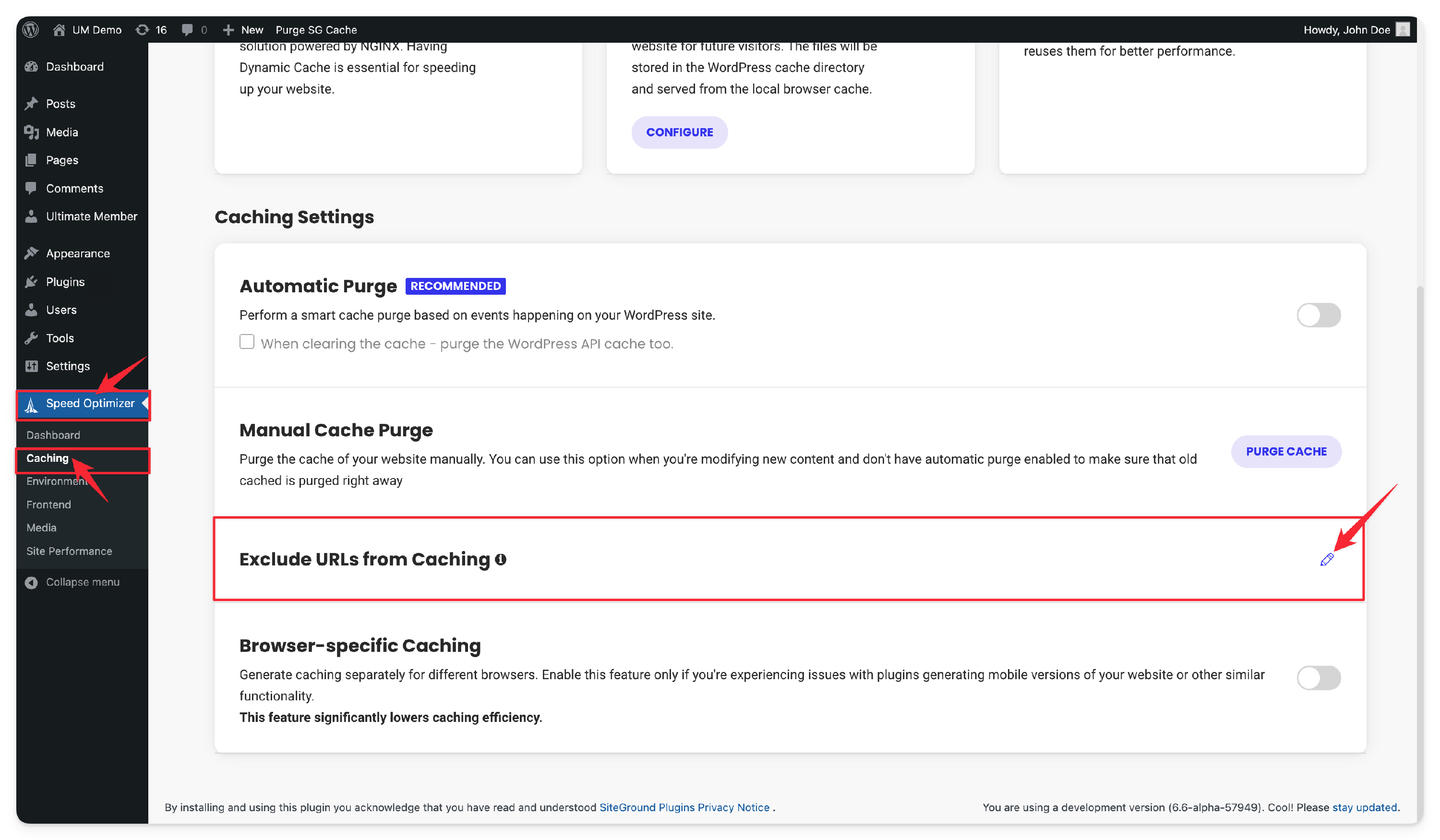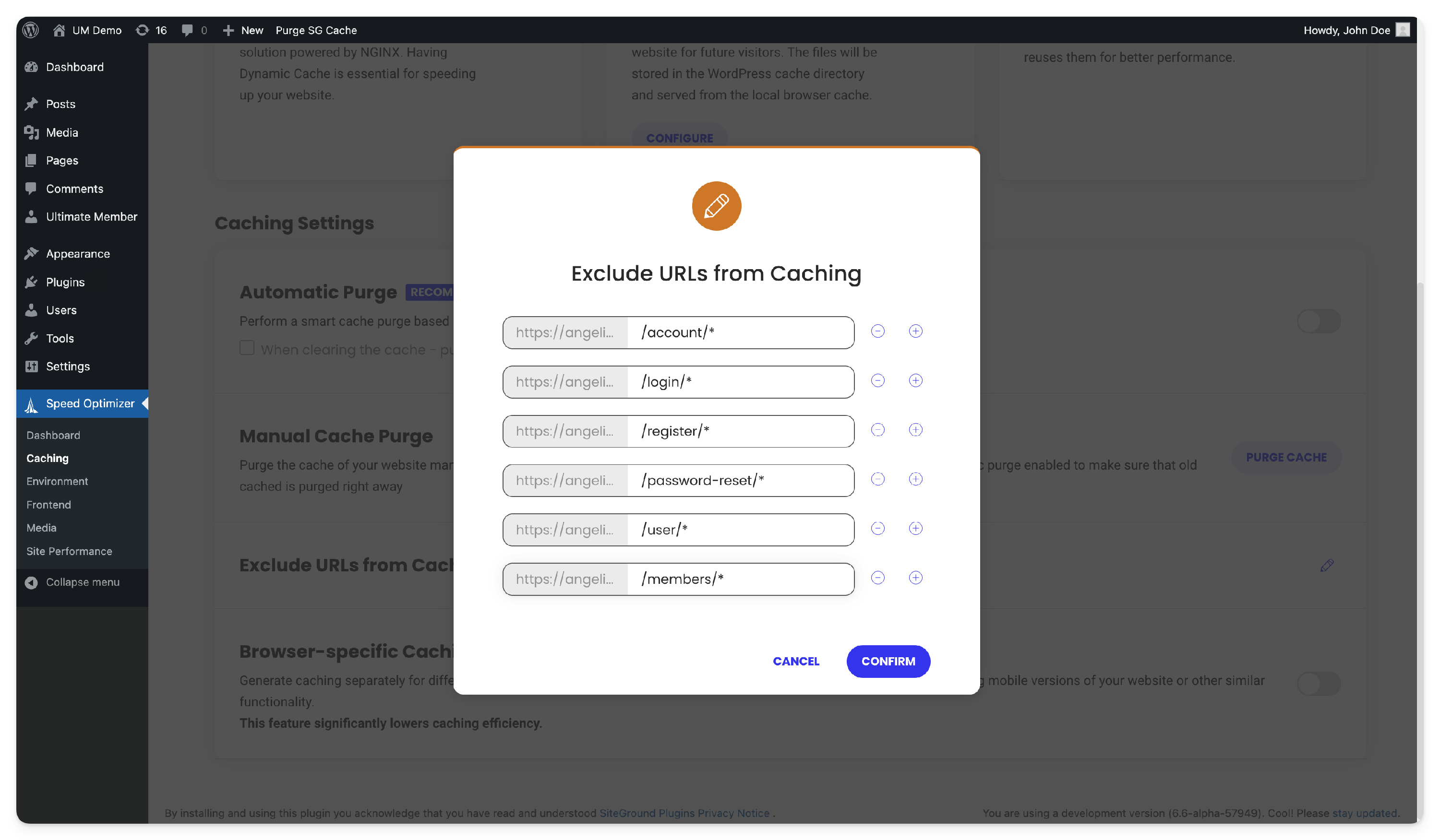Caching problems
Common caching issues #
Authorization and Privacy
Caching may interfere with authorization features such as login, registration, and password reset pages, making them non-functional or insecure.
The Account and User Profile pages contain private user information. If cached, this data could be displayed to the wrong user.
The Members page contains a directory that uses secure requests. Caching this page may result in errors or stale content.
Content Restriction and Redirects
Caching can cause restricted content or redirects to behave incorrectly by saving one user's view and displaying it to others. Always disable caching on pages that use content restriction or redirection.
Multiple Caching Plugins
Avoid using multiple caching plugins. This practice can lead to broken layouts, functionality issues, and increased error risks. Use only one caching plugin and deactivate any others.
Hosting Cache
Some hosts use server-level caching. While this is often optimized, you must ensure that key pages are excluded from being cached. Refer to the hosting-specific instructions below.
How to Disable Page Caching #
You must disable caching for the following Ultimate Member pages to prevent broken layouts, privacy issues, or functionality problems:
- Login
- Register
- Password Reset
- Account
- User (profile)
- Members (optional — only if it displays incorrect or outdated content)
The method for excluding these pages depends on the caching plugin or hosting tool you are using. See the sections below for plugin-specific and host-specific instructions.
Note: Use clean permalinks (e.g.,/register/) instead of query-based URLs (e.g.,/?page_id=123). You can confirm this at WP Admin > Ultimate Member > Settings > General > Pages or by checking under Pages > Quick Edit.
Breeze
Go to wp-admin > Settings > Breeze > Advanced Options and use the Never Cache URL(s) setting to exclude pages. Read the Breeze documentation for details.
Cloudflare
Use the Cloudflare Page Rules tool to disable caching for certain pages. To view page rules, log in to the Cloudflare dashboard. Select the domain where you want to edit your page rule and click the Rules app. In the Page Rules tab, locate the rule to edit.
You can use the asterisk (*) in any URL segment to match certain patterns.
Recommended settings for pages excluded from cache:
- Cache Level: BYPASS
- Origin Cache Control:
no-cache, no-store, must-revalidate - Rocket Loader: OFF
Google Cache
If your site uses Google Cloud Storage (GCS) to host static files like profile photos or user-uploaded content, be aware that GCS may cache these files automatically. This can lead to outdated images or incorrect content being shown to users.
To prevent caching issues, make sure sensitive or user-specific files (e.g., avatars) use proper Cache-Control settings like no-store. Note that GCS does not support manual cache clearing, so versioning file names is recommended if updates are needed.
For more details, see the official Google Cloud Storage caching documentation: https://cloud.google.com/storage/docs/caching
Hummingbird
Use the Exclusions - URL Strings setting on wp-admin > Hummingbird > Caching to exclude pages.

LiteSpeed Cache
Use the Do Not Cache URIs setting on wp-admin > LiteSpeed Cache > Cache > Excludes to exclude pages. Read the article Cache for details.

SG Speed Optimizer (SiteGround)
SiteGround’s Speed Optimizer includes caching via its SuperCacher system. By default, it does not cache content for logged-in users, which is the recommended behavior for Ultimate Member.
However, SG Optimizer also includes an option to enable “Logged-in Users Cache.” If this is turned on, SiteGround will generate separate cache versions for each logged-in user. This can cause unexpected behavior with Ultimate Member, including issues switching between profile and account pages. See more info here.
Recommendation: Do not enable “Logged-in Users Cache”. Instead, rely on SiteGround’s default behavior which skips caching for logged-in users entirely.
To exclude Ultimate Member pages from caching, follow these steps:
- Go to wp-admin > Speed Optimizer > Caching > Exclude URLs from Caching

- Add the following paths (adjust to your site’s URL structure):
- /login/
- /register/
- /account/
- /user/
- /members/
- /password-reset/

- Save changes.
For additional guidance, refer to SiteGround’s documentation SuperCacher Controls – SiteGround Tutorial
Sucuri Firewall
If your site uses the Sucuri Firewall, you can exclude specific Ultimate Member pages or assets from being cached to avoid issues with outdated or incorrect content.
To disable caching for specific URLs:
- Go to your Sucuri Firewall Dashboard.
- Navigate to Performance > Non-Cache URLs.
- Add the full URL of the page or file you want to exclude (e.g.,
/register/,/account/, etc.). - Click Add URL to save.
Note: Sucuri caches static files like images, CSS, JS, and PDFs on their edge servers. To ensure updates are reflected, use versioning (e.g., style.css?ver=1.2) or manually clear the firewall cache when needed.
Learn more here: Sucuri Cache Exceptions
Varnish Cache
EasyWP hosting by Namecheap uses Varnish cache by default. If your site is hosted on EasyWP or another platform that uses Varnish, caching can be compatible with Ultimate Member as long as the correct URL exclusions are in place.
Varnish is typically configured to bypass caching for logged-in users and specific URLs that are commonly used for login, registration, and profiles. These default rules help avoid issues with user privacy, redirects, and stale content.
Default Varnish exclusions (example VCL rules):
/login /logout /lost-password /my-account /register *profile_nocache *user_nocache *members_nocache
If your Ultimate Member pages use these paths or include nocache in the URL, they will usually be excluded from caching automatically - no manual action is required.
References:
There’s no need to contact your host if your URLs follow this pattern. Just make sure your Ultimate Member pages use clean, non-query permalinks and include /nocache/ in the slug if needed.
W3 Total Cache
Use the setting Never cache the following pages on wp-admin > Performance > Page Cache to exclude pages. See FAQ.

WP Engine
Use WP Engine custom cache exclusions to disable caching for certain pages. To view custom cache exclusions, visit the Caching options page in your User Portal.
WP Fastest Cache
Use the Exclude Pages setting on wp-admin >WP Fastest Cache > Exclude to exclude pages. See examples here.

WP-Optimize
Use the setting URLs to exclude from caching on wp-admin > WP-Optimize > Settings > Cache > Advanced settings to exclude pages. Read the Advanced settings – exclude URLs for details.

WP Rocket
Use the setting Never Cache URL(s) on wp-admin > Settings > WP Rocket > Advanced Rules to exclude pages. Read the article Exclude Pages from the Cache for details.

This plugin has a feature that defer JS files loading, that may cause critical JavaScript errors. Please disable the Load JavaScript deferred and Delay JavaScript execution features if you see JavaScript errors in the browser console.
WP Super Cache
Use settings on wp-admin > Settings > WP Super Cache > Advanced to exclude pages.

How to disable image caching #
Jetpack
The Jetpack site accelerator copies images to domains i0.wp.com, i1.wp.com, i2.wp.com or i3.wp.com and cache them, then replaces original images. This feature influence profile photos, please disable it. Go to wp-admin > Jetpack > Settings > Performance and turn off the setting Speed up image load times.


